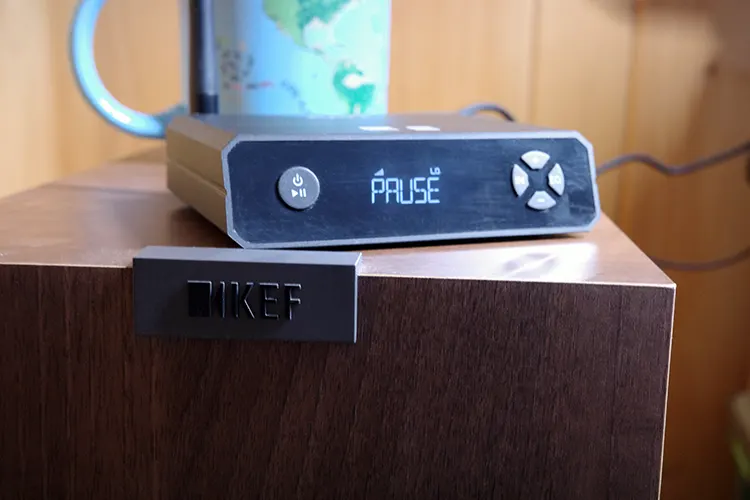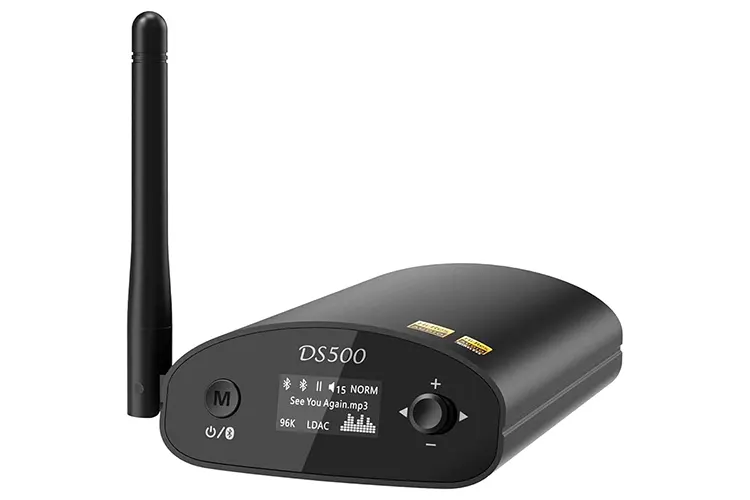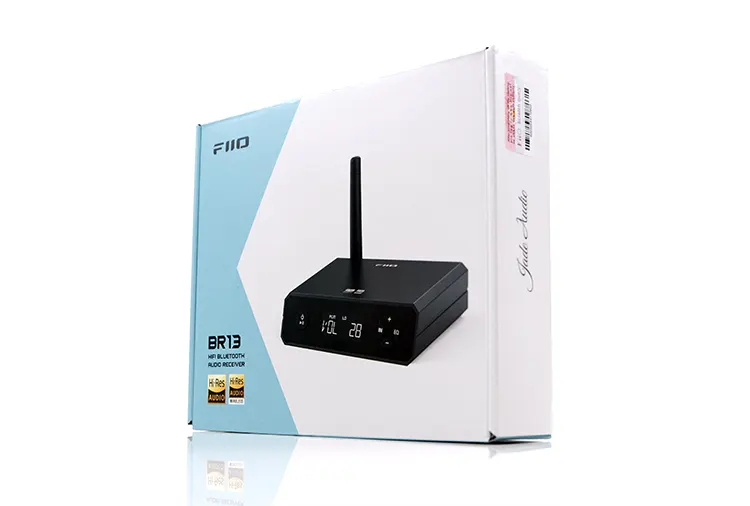Sound Impressions
I was unable to give the BR13 as much run-in time as I would have liked, but the listening sources were well broken in, and the time I listened to various sources and outputs (well over 75 hours) was adequate.
BT was through my Klipsch Heritage The Sixes, while two-channel systems bounced between the Yamaha A-S301/KEFG Q150 combination and Denon PMA-770/Klipsch forte II.
Summary
The BR13 was hooked to my Yamaha A-S301 & KEF Q150 (BT & optical cable), Klipsch Heritage The Sixes (BT & optical cable), and my Denon PMA-770 & Klipsch forte II (RCA Lineout), using my iPhone 13 Pro Max and the Cayin N6ii streaming through Tidal. The FiiO Control app was used on my iPhone to gauge EQ settings and Global Upscaling (vs Compatible).
Source plays a part in the overall character of the BR13, more so than other devices I have tested of late.
This isn’t necessarily a bad thing, though. Quick listens through my iPhone using either Compatible or Global Upscaling gives a pleasant sound quality to it, with Global Upscaling sound fuller and with better texture to the music. There was a significant difference for me.
Using the Cayin under BT, and LDAC, that sound quality became even more prevalent, with better detail retrieval and clarity to the songs played. USB-C DAC mode raised the quality a bit more as well.
The versatility of listening choices became readily apparent quite quickly. The above observations were made across all listening sources and playback systems.
Timbre
The combination using the Cayin N6ii through any of the connections provided a somewhat laidback signature, matching the smoothness of the music played. Detail using the BT LDAC and USB DAC was the best, providing excellent clarity and a naturalness to the music.
Playing the music at lower volumes did not decrease the clarity either, with the full nature of the songs coming through with a realism, that showed very good textural character and weight.
The music was coherent and with a natural organic note to it, which did not become slow or unrealistic. Lower-end extension allowed for the notes to linger, much like a richer source would, but without becoming tedious or dragging.
It is somewhat evident that the midrange is pushed forward, which can accommodate that feeling of evenness to the tonality while presenting the somewhat laidback character.
It is said that the best devices allow the music to be played unencumbered by external forces. The BR13 allowed the recordings to come through with a realistic sound, which was intended with very good clarity adding to the textural response.
Staging & Dynamics
Going through the sources and upscaling/DAC options, there was a definite hierarchy to the sound. AAC through the iPhone was pleasant, but with an intimateness that seemed crowded, much like AAC compresses their sound.
Global Upscaling added much-needed soundstage width and height, with only depth still seemingly lacking. Switching to the Cayin and LDAC BT or USB DAC added to that missing depth, allowing the music to show a precision in placement that was lacking in the other sources.
Note texture progressed this way as well. The better the source and connection options, the better the response. This makes absolute logical sense, but the seeming ease with which the BR13 did this was still a surprise. Spatial representation also benefitted from becoming natural and more coherent.
The better the connection option, the more open the soundstage became, which led to better placement of the instruments as well. Texturally, the notes did not become thinner with the upscaling but filled in the necessary space with alacrity.
Transients are smooth, which you would think hinders texture, but instead allows the notes to be present with good detail. Good resolution plays a part in this as well, allowing for the textural response to be heard as individual parts, but summed up with the whole.
The only thing lacking is an extension up top, with a rounded upper end. This would add more spatial acumen to the picture, had FiiO showed the same extension up top, that the BR13 does below.
Synergy
As mentioned above, the BR13 played well across many sources. Some are better than others. However, the versatility of the device cannot be understated. This paired easily with everything thrown its way.
Pairings
Compared across different platforms, the BR13 worked effortlessly; easily connecting to two different BT devices simultaneously.
When paired with the Yamaha A-S301/KEF Q150 using the optical cable, the sound came across as finely defined, but with good weight to the notes. There were no instances of reaching for the volume knob to accommodate low-level portions.
The textural response had good weight to the notes, and definition, with only the depth of the soundstage suffering a bit. Spatial awareness was good, and picking out placement within the 3D framework was done without bother.
The funniest pairing might have been with the Klipsch Heritage The Sixes. A mid-level powered speaker known for its low-end, the punchiness came through when using Tidal to stream. Klipsch speakers are known for being energetic, and The Six is no different. Somewhat to the detriment of micro-detail though.
That did not matter as the BR13 provided the music for the energy. Deep-reaching bass, and mids, which shone highlighted the pairing. The upper end did not become screechy or honky, either, and presented a clean, tight sound.
The Denon PMA-770 is in service while my Macintosh MA6100 gets serviced, and the replacement is a very adequate substitute. Presenting a thinner, less meaty sound than the Mac, the Denon is better at the micro-detail level, which pairs nicely with the Klipsch forte II’s.
Running the Cayin N6ii through the BR13, which was hooked to the Denon using the RCA lineout connection, the combination provided a clear, crisp, detailed sound. The BR13 allowed the music to flow through with ease, lacking only in that depth again. Height and width were on par with the other setups.
Select Comparisons
1Mii DS500
Technical
Bluetooth 5.1 using the same Qualcomm QCC5125 Bluetooth chip and ES9018K2M DAC chip, highlight the DS500. The 1Mii also features support for LDAC audio codec, Qualcomm aptX HD, aptX Low Latency, aptX, SBC, and AAC decoding. In other words, just like the BR13
Design
Set on the same sized parameters, the DS500 measures 5.5 x 10 x 3.3mm, and weighs 357g; which is much heavier. The shape takes on a Quonset hut shape reminiscent of old barracks on military bases. Not in a bad way, though.
There is more information on the OLED screen but in much smaller lettering. From my seating position with the Denon system, I could not make out anything. You do get the song, which is displayed in letters, along with bitrate, codec, BT status, and EQ tuning.
Flanking the OLED display is the power button on the left, which doubles for pairing (long press for two seconds), and the multi-function toggle on the right.
The toggle controls volume (press up and down respectively), along with rewinding to the beginning of the song to the left, or fast forwarding to the next song to the right. The EQ settings (normal, rock, classical, jazz, dance, pop, and bass) are accessed by pressing the toggle for two seconds. Once chosen, the EQ mode exits automatically.
Bluetooth operation is also similar to the BR13 at 30m unobstructed. I found the same limitations as the BR13 as well. Lacking only an optical input hook-up, the two were similar in their connectivity arrangements.
Performance
Immediately, the DS500 permeated the Denon system, with a slightly deeper reach, and better depth to the soundstage. There was also a certain smoothness to the sound, which made it a bit more mature in sound than the BR13.
The midrange punched a little meatier as well, but that could be due to the DS500’s ability to drive the source more easily.
The DS500 can get loud quickly, with a much less defined volume jump than the BR13. The raising or lowering of volume on the BR13 was smoother, with less of an audible jump. The DS500 was much more noticeable.
With thicker notes, but better defined in attack and decay, the DS500 provided a weightier sound, with slightly better clarity as well. A preference for either will come down to affordability, source options, and power.
Our Verdict
There are a multitude of streaming/Bluetooth devices on the market currently. Many boast the same features, with the newest technology. Along with those claims comes a price. The FiiO BR13 uses existing technology and tries to make it better as an affordable option. It largely succeeds.
From the ability to globally upscale, and the different connectivity options, the BR13 has everything you would want or need in a device, which can bring your two-channel system into the streaming world, except Roon Ready technology. No big deal. For what the FiiO brings to the table, it is an outstanding unit.
Sound, which compares quite favorably to others, and every connectivity option that the vast majority would currently need to utilize. Does it sound the best? No, the compared 1Mii sounds a bit more mature to me.
But for what the FiiO is, it provides an outstanding option to those looking for a small unit, which can run their two-channel systems as well as powered speakers in small spaces. And that may be its highest praise.
FiiO BR13 Technical Specifications
- DAC: ES9018K2M Reference
- Hi-Res files up to 32-bit/96kHz
- Streaming: up to 24-bit/192kHz compatible
- Bluetooth: BT 5.1, Qualcomm QCC5125 chip
- TPA1882 op-amp
- USB input, optical input, optical output, coaxial input/output, and RCA interface
- BT Codecs: aptX HD, LDAC and aptX Adaptive, SBC, and AAC
- Signal-to-noise ratio: ≥113dB
- Noise floor: <5uV (A-weighted)
- Output impedance: <6Ω (32Ω load)
- THD+N: ≤0006% (Non-BT), <0.002% (BT LDAC)







